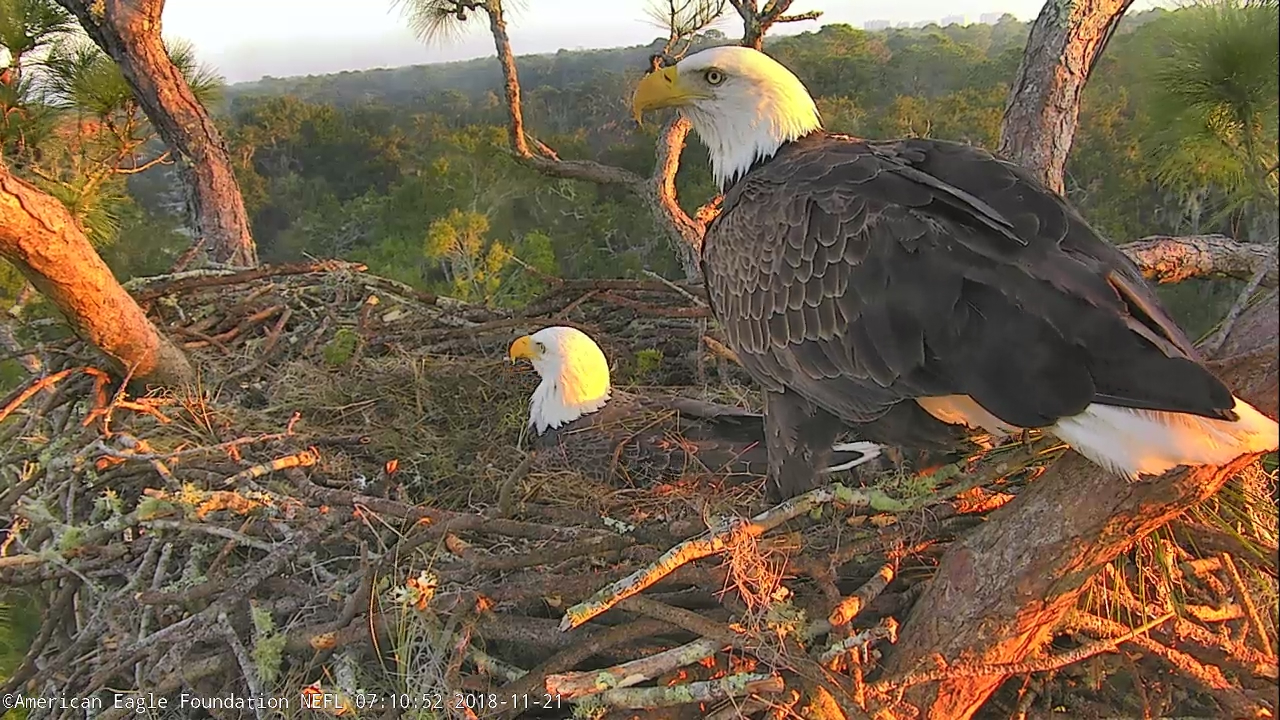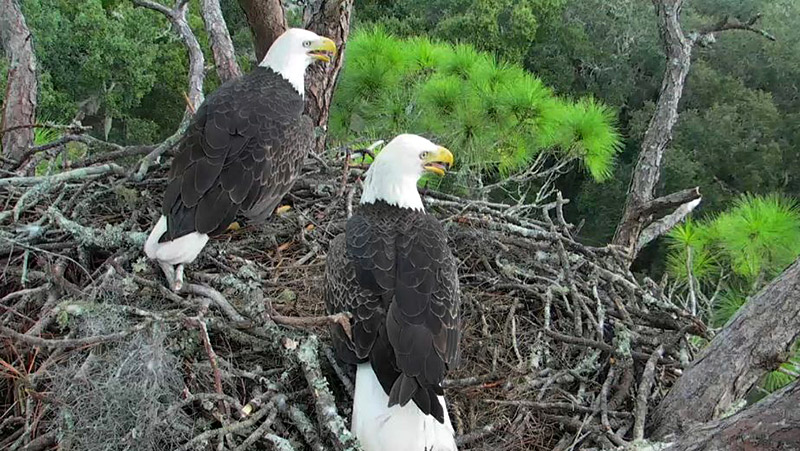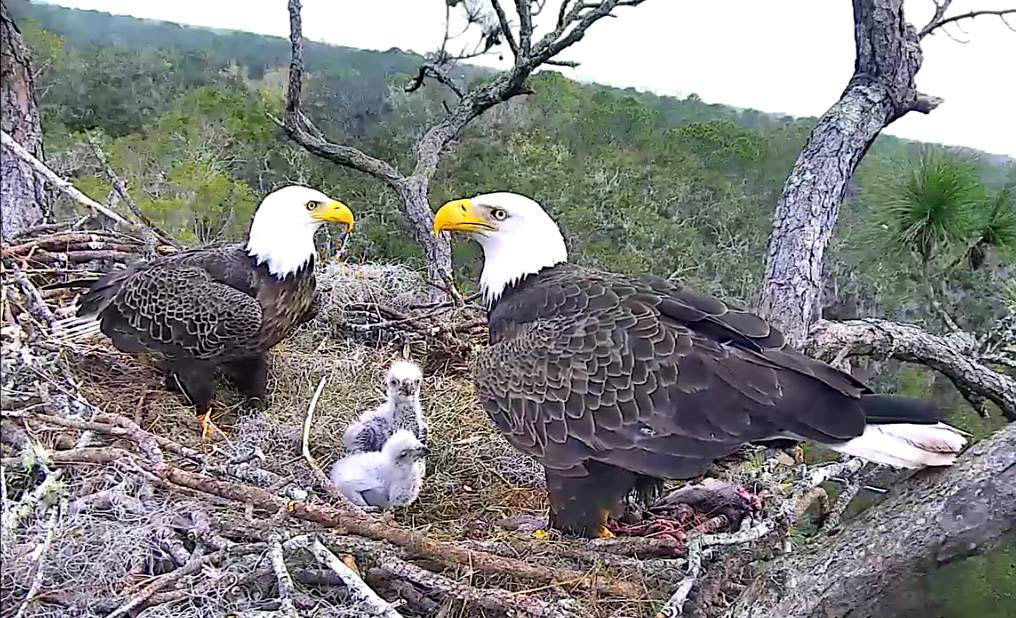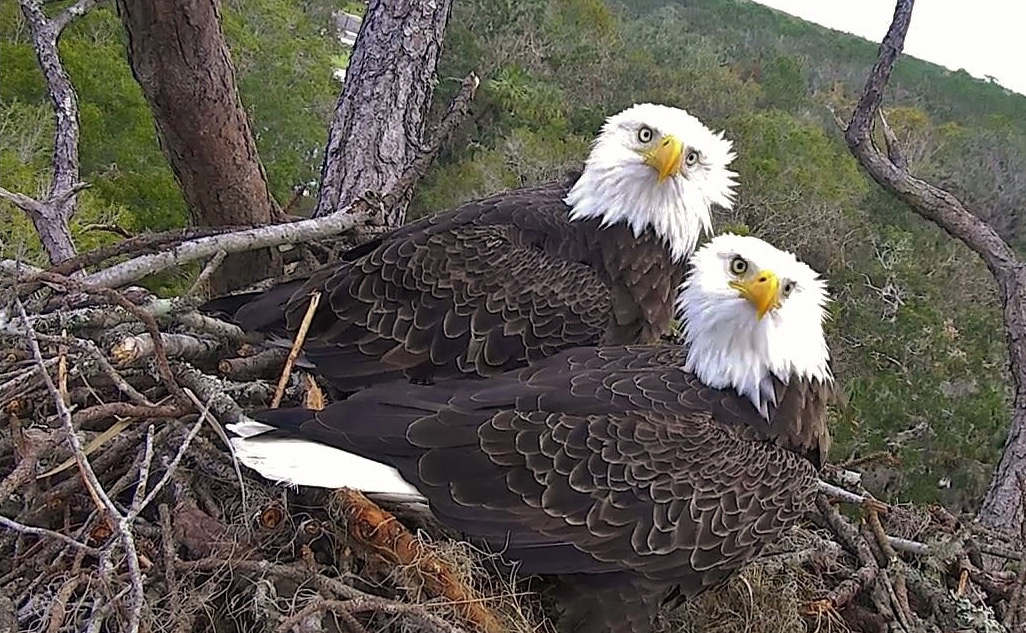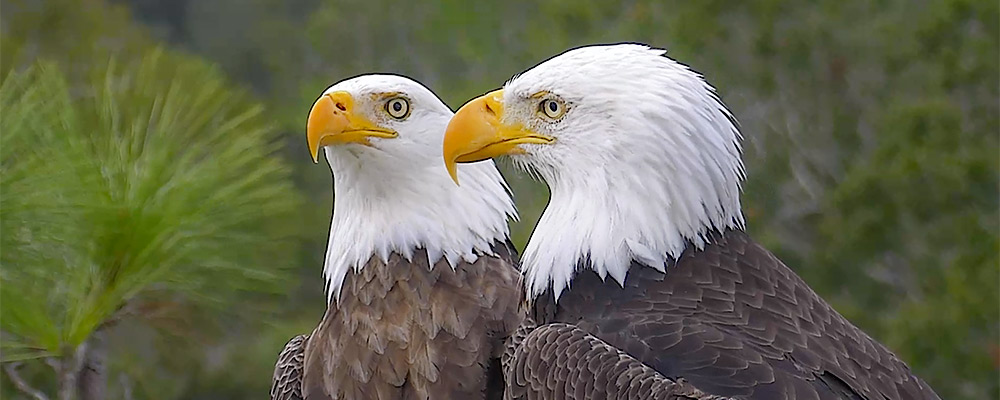About Romeo & Juliet
Northeast Florida Wild Bald Eagle Nest
The 2018-2019 Season began normally for Romeo & Juliet. Two eggs were laid, but several large mature eagles disturbed the peace and tranquility of this nest. The expectations of the season ended in heartache as Juliet returned to the nest with an injury and was subsequently driven from the nest by a rival just days before the eggs were to hatch, leaving Romeo to do the work of two. When an egg hatched on Christmas Day 2018, a female eagle following Romeo to the nest swooped down and took the hatchling. The following day, Romeo left the area and neither Romeo nor Juliet has been seen since.
The Q & As that follow reflect the past history of the nest while Romeo & Juliet were the resident eagles.
How old are Romeo and Juliet?
It is unknown, but because Bald Eagles do not reach sexual maturity until 5 years, and this pair has been documented since 2008, you can assume they were at least 5 years old at that point. By 2018/2019, we estimate they would be at least 16/17 years old – and they might be older!
How Was the Nest Discovered?
In 2006, surveyors working in the area discovered the nest. They alerted the proper authorities and all the protections were put into place so not to disturb their nesting area. In 2008, Gretchen Butler started monitoring the nest for Audubon and has done so since then, along with a timeline for each year. More information on the protection of Bald & Golden Eagles.
Where do Romeo and Juliet go in the off season?
We have no idea where they go because they are not tracked or banded.
How can you tell Romeo and Juliet apart?
When they are beside each other, Juliet is larger. Romeo’s nares (nostrils) are oval and more defined than Juliet’s, whose nares are somewhat curved, or tear shaped. In the image, Juliet is on the left; Romeo on the right. Romeo has some ‘speckles’ in the iris of his eye—seen in close view affected by lighting whereas Juliet’s irises are clear. Romeo has a dark streak in his tail feathers, but Juliet’s tail feathers are completely white. Juliet has a signature white feather on her right leg and dark feathering on the nape of her neck.

How many eggs did Juliet lay each season?
Juliet laid 2 eggs each year since 2008, with the exception of only 1 in 2009-2010 season.
How many successful fledges have there been since this pair has been observed?
19 from 2008 through 2018.
What other birds or animals have visited the nest or nest tree during nesting season?
- Barred Owl
- Red Shouldered Hawk
- Peregrine Falcon, Vultures
- Juvenile and Adult Bald Eagles
- Great Blue Heron
- Osprey
What Are Romeo & Juliet’s Favorite Branches On The Nest Tree?
Our Cam Operators and Moderators have identified favorite branches on the nest tree where Romeo & Juliet like to perch. Names have been given to these branches, and are sometimes referred to in Chat or in the Event Log. To assist our viewers in identifying the branches, one of the cam operators has labeled these branches!

When do the Ropes & Signs Go Up to Protect the Nest from Disturbance?
The ropes and signs surround the immediate nest area and are put up once incubation starts. They are removed once the fledglings have achieved skill in flight and landings (which is approx. 3 wks after fledge).

What’s On the Menu for Romeo & Juliet and Their Eaglets?
Romeo and Juliet are excellent providers and their eaglets are always well fed. Our moderators have carefully documented what has been brought into the nest. This information was last updated 3/10/18.
Fish/Eel/Reptiles
- American Eel
- Striped Bass
- White Bass
- Sunshine Bass
- Largemouth Bass
- Bluegill
- Asian Grass Carp *
- Common Carp
- Black Channel Catfish
- Blue Catfish
- Channel Catfish (light gray/bluish in color)
- White Catfish
- Crappie
- Redfish
- Jack Crevalle
- Horse-eye Jack
- Ladyfish
- Lookdown Fish
- Needlenose Gar
- Florida Gar
- Fantail Mullet
- Silver Mullet
- Striped Mullet
- Permit
- Pompano
- Red Porgy
- American Shad
- Snook
- Mangrove Snapper
- Red Ear Sunfish
- Spotted Tilapia, Blue Tilapia
- Snapping Turtle (roadkill)
Birds/Mammals
- American Coot
- Armadillo tail
- Small heron
- Rabbit
- Squirrel
- Woodstork (roadkill)
Documented Offspring of Romeo & Juliet since 2008.
On Ground Observation Documentation
NOTE: No video cams were available for documentation from 2008 – 2013, but expert observation from the ground by use of a scope and watching the behavior of the eagles can accurately determine when the first egg was laid (but not the second), and when the first egg hatched (but not the second).
2008-2013
2008-2009
Jock & Jill
First egg laid: Nov. 28, 2008
First hatch date: Jan. 2, 2009
Fledge Date: March 18, 2009
2009-2010
One eaglet. Not named.
Egg laid: Nov. 18, 2009
Hatch date: December 23, 2009
Fledge date: March 15, 2010
2010-2011
Two eaglets. Not named.
First egg laid: Nov. 7
First hatch date: December 12, 2010
Fledge dates: February 28, 2011 (male); March 3, 2011 (female)
2011-2012
Whitey & Dudley
First egg laid: Nov. 2
First hatch date: December 9, 2011
Fledge Date: March 5, 2012 (both)
2012-2013
Jack & Lo
First egg laid: November 9, 2012
First hatch date: December 16, 2012
Fledge dates: Jack – February 27, 2013; Lo – March 4, 2013
Documentation by Video Cams
2013-2019
2013-2014
Samson & Delilah
Eggs laid: November 14, 2013 & November 17, 2013
Hatch dates: December 20, 2013 @ 4:26pm / December 23, 2013 @ 12:08 a.m.
Fledge dates: Samson – March 8, 2014; Delilah – March 12, 2014
2014-2015
Nick & Noel
Eggs laid: November 16, 2014 & November 19, 2014
Hatch dates: December 23, 2014 @ 12:48 p.m. & December 25, 2014 @ 2:56 p.m..
Fledge dates: Noel – March 15, 2015; Nick March 19, 2015
2015-2016
Liberty & Justice
Eggs laid: November 16, 2015 & November 19, 2015
Hatch dates: December 22, 2015 @ 5:18p.m.; December 24, 2015 @ 6:51p.m.
Fledge dates: March 19, 2016 (both eaglets)
2016-2017
Peace & Hope
Eggs laid: November 11, 2016 & November 14, 2016
Hatch dates: December 18, 2016 @ 10:27 a.m. & December 20, 2016 @8:38 a.m.
This season included a rescue, rehabilitation, & release of Eaglet Peace. Peace was observed with balance issues in the nest. It was also observed that a black monofilament (fishing line) was around Peace’s left foot. A decision was made to remove Peace from the nest, and that was done on February 10, 2017. After examination, Peace was taken to the Audubon Center for Birds of Prey in Maitland Florida for further observation, treatment, and rehabilitation. Peace remained there until his flight capability was stable and strong.
Peace (a male) was released in the nesting area on March 14, 2017
Hope fledged March 2, 2017
2017-2018
Sky & Spirit
Eggs laid: November 2, 2017 & November 5, 2017
Hatch dates: December 9, 2017 @ 2:10 p.m.; December 11, 2017 @ 3:42 p.m.
Fledge dates: Sky: Feb. 23, 2018; Spirit: February 25, 2018
2018-2019
Eggs laid: November 14, 2018 & November 17, 2018
Depending on their age, what are young eagles called?
Hatchling = at hatch and just a few days following
Nestling = eaglet still in nest
Eaglet = all of the above
Fledgling = eaglet that has taken flight yet not independent
Juvie = fledgling in first year
Immature/Sub-Adult = eagle 2 – 4 years old
Adult = 5 years and/or capable of breeding

